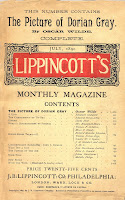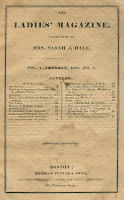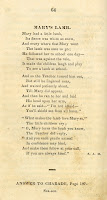Here's a treat for you. something I wrote a while back but still very current. There is no book on movie magazines in existence. Here's the most comprehensive bibliography ever compiled of all movie magazines published to 1950. enjoy!! if you'd like the rest of the book containing many fabulous images, drop me an e-mail at
lomazow@comcast.net and i'll send it as a pdf file.
if you know of or have any titles not listed, let me know and i'll add them.
Despite the enormous popularity and size of the movie industry, there has been very sparse bibliographic study of the magazines issued in conjunction with it. A recent perusal of internet search engines rather amazingly confirms that there is virtually no other comprehensive source, despite the fact that many of the actual early films have been lost and the only remaining documentation exists in printed form. Other than the chapter in my 1996 volume, the following is the only comprehensive visual and textual treatment of the subject, new and improved, emphasizing the pre-1940 era, with a few selected major titles afterwards. All illustrations are from the author’s personal collection. The focus has been to obtain the first issue of a title, though when rarity (not infrequently) supervenes, type issues are employed.
Source material is very sparse. The initial list began with the only two existing resources in 1996:
The Union List of Film Periodicals by Brady, Wall and Weiner, Greenwood Press, 1984
International Film, Radio and Television Journals. Edited by Anthony Slide, Greenwood Press, 1985
and was expanded with exhaustive research as well as prospecting for new titles and information at antiquarian bookfairs, ephemera shows and on the internet (primarily eBay). The latter has been most fruitful. This list has been twenty years in the making. It is now quite unusual to find something new, suggesting that it is getting fairly close to complete (being an avid collector, the author wholly realizes that there is always potentially something new in the next booth or listing, hence the fun of it all!). In nine years of intensive searching, only about ten new titles have been added. Many of these have only been seen once. Early Movie Magazines are very rare birds indeed; ephemeral in the true sense of the word, despite their relatively recent vintage.
Movie Periodicals can be roughly divided into five categories:
1) Fan Magazines- intended for the general public as a vehicle to increase viewing interest
2) In-house Magazines- issued by individual studios to promote their films to distributors
3) Exhibitor’s or Trade Journals- employed by movie distributors and exhibitors, containing much about the films themselves, especially new releases, often with graphic advertising.
4) Technical Journals- designed for members of the industry for technical and creative
information
5) Movie Pulp Magazines- fiction magazines based on either movie screenplays or movie themes
The list is chronological, from the origin of the earliest title. Technical journals are excluded.
A Bibliography of American Movie PeriodicalsFan Magazines Motion Picture Story Magazine (February 1911) title changed to
Motion Picture Magazine (March 1914)
Photoplay Magazine (August 1911)
Motion Picture Album (June 1912)
Movie Pictorial (1913)
Moving Picture Stories (January 3, 1913)
Motion Picture Times (1915)
Who’s Who in Moving Pictures (1915)
Motion Picture Mail (1915) A weekly Supplement to The Daily Mail newspaper
Photoplay Vogue (1915)
Weekly Movie Record (1915)
Movie Magazine (March 1915)
Film Players Herald and Movie Pictorial (March 1915)
Picture Play Weekly (April 10, 1915) title changed to
Picture Play Magazine (October 3, 1915) title changed to
Picture Play (March 1927) title changed to
Charm (March 1941)
Feature Movie Magazine (March 15, 1916)
Photoplay Review (March 16, 1915)
Film Fun (July 1915) an amalgamation of three non-movie titles
Motion Picture Supplement (September 1915) title changed to
Motion Picture Classic (December 1915) title changed to
Classic (September 1922)
Wid’s Films and Film Folk (September 9, 1915)
Photo-Play Journal (May 1916)
Photoplay Weekly Mirror (September 30, 1916)
Photoplay World (September 1917)
The California (June 23, 1918)
Shadowland (September 1919) some non-movie content
Screenland (New York) (September 1920)
Filmplay Journal (1921)
Hollywood Informer (1921)
Pantomine (1921)
Photo Drama (1921)
Movie Weekly (February 12, 1921)
Screenland (Seattle) (May 1, 1921)
Filmplay Journal (July 1921)
Movie Melody Magazine (July 1921)
Silver Screen (March 23. 1922)
Motion Picture Review (1922?)
Cinema Art (1923)
Movie Monthly (March 1924)
Hollywood (September 20, 1924)
Movie Adventures (October 1924) title changed to
Movie Thrillers (January 1925) title changed to
Movie Magazine (September 1925) title changed to
Pictures (May 1926)
Movie Digest (March 1925)
So This is Paris (March 1925) title changed to
Paris and Hollywood (April 1926) title changed to
Paris and Hollywood Screen Secrets (1928) title changed to
Screen Secrets (April 1928) title changed to
Screen Play Secrets (April 1930) title changed to
Screen Play (October 1931)
Motion Picture Monthly (September 1925)
Hollywood Life (November 1925)
Screen Book (July 1928) title changed to
Screen Life (March 1940)
Movie Romances (December 1928)
Screen Romances (June 1929)
New Movie (December 1929)
Passing Show of Today (December 1929)
Cinema (January 1930)
Talking Screen (January 1930)
Modern Screen (November 1930)
Silver Screen (November 1930)
Screen Romances Album (February 1931)
Screen Album (March 1931)
Movie Classic (September 1931)
Movie Mirror (November 1931)
Screen Weekly (September 1932)
Shadowplay (March 1933)
Golden Screen (August 1934)
Screen Star Stories (August 1934)
Popular Screen (September 1934)
Movie Life (November 1937)
Moviepix (February 1938)
Trade JournalsFilm Index (Views and Film Index) (April 26, 1906) Absorbed by Moving Picture World,
July 1, 1911
Variety (December 16, 1905) Initially a theater magazine which evolved into a movie magazine
Moving Picture World (March 9, 1907) Merged with Exhibitor’s Herald to form
Exhibitors’s Herald and Moving Picture World (January 7, 1928) title changed to
Exhibitor’s Herald World (January 5, 1929) title changed to
Motion Picture Herald (January 1931)
Moving Picture News (May 1908) title changed to
Motion Picture News (October 11, 1913) Absorbed by Moving Picture World, January 3, 1931
Nickleodeon (1909)
Motography (April 1911) Absorbed by Exhibitor’s Herald (1918)
Exhibitor’s Times (May 17, 1913) Absorbed by Moving Picture News (October 1913)
Moving Picture Publicity (December 1913)
Photoplayer’s Weekly (1914)
Photoplay Scenario (May 1914)
Exhibitor’s Herald (June 24, 1914) merged with Moving Picture World to form Exhibitor’s Herald and Moving Picture World, (January 7, 1928)
Film Daily (June 1922)
Photoplay Weekly Mirror (September 30, 1916)
Exhibitor’s Trade Review (December 9, 1916) title changed to
Exhibitor’s Daily Review (February 6, 1926)
Cinema News (December 15, 1916)
Affiliated Committees for Better Films Bulletin (1917) title changed to
Film Progress (1924)
Dramatic Mirror of the Stage and Motion Pictures (February 17, 1917)
Camera (April 1918)
Vine Street (November 15, 1918)
It (1920)
Exceptional Photoplays (November 1920)
Screen (1921)
Film News (1923) title changed to
National Ehibitor (August 15, 1927)
Motion Picture Record (1924)
Photoplay Guide to Better Pictures (June 1924)
Film Spectator (June 1926) title changed to
Hollywood Spectator (June 20, 1931)
National Board of Review Magazine (March 1926) A merger of Film Progress, Vine Street and Motion Picture Record
Hollywood Filmograph (1927)
Brevity (July 1927)
Le Cinema (September 1927)
Motion Picture Arts and Sciences (November 1927)
Talking Picture Magazine (October 1929)
Motion Picture Advertising (November 1929)
Hollywood Reporter (1930)
Motion Picture Daily (December 22, 1930) Absorbed Exhibitor’s Daily Review
Hollywood Herald (June 8, 1931)
Box Office (January 21, 1932)
Showmen’s Round Table (May 27, 1933)
Jones’ (1937)
Cinema Arts (June 1937)
In-House PublicationsBiograph Bulletin (1902-1912)
Edison Kinetogram (1909)
Bison Magazine (1910)
Essanay News, Essanay Guide (1910)
Selig Polyscope Guide (1910)
Vitagraph Bulletin (1910)
Eclair bulletin (1910-1914)
Film Fancies (Carlton Motion Picture Company) (1910)
Kalem Kalendar (1911-1914)
Vitagraph Exhibitor (1911-1915)
Mutual Film Magazine (1912)
Reel Life (Mutual Films) (1912-1917)
Implet (Carl Laemmle) (January 10, 1912)
Universal Weekly (June 22, 1912) title changed to
Moving Picture Weekly (1915) title changed to
Universal Weekly (1922)
Movies (General Film Company) (1913)
Pathe Fortnightly Bulletin (1913) title changed to
Pathe (April 15, 1915)
Lubin Bulletin (October 27, 1913)
Paramount Progress (1914) title changed to
Picture Progress (June 1915)
The Biograph (September 5, 1914)
Paste, Pot and Shears (Selig) (1915)
Triangle ( 1915-1917)
Metro Pictures Magazine (September 1915)
Fox Folks (Fox Films) (1916)
Sherry Punch (Sherry Features) (1916)
Mack Sennett Weekly (1917-1919)
Studio Skeleton (Samuel Goldwyn) (1919)
Film Follies (Christie Films) (1919)
Loew’s Weekly (December 6, 1920)
Dotted Line (1922-1926)
Distibutor (MGM) (1925-1941)
Movietone Bulletin (June 11, 1928)
Columbia Mirror (November 1934 - October 1941)
MGM Studio News (1935-1940)
MGM Studio Club Club News (1935-1936)
RKO Studio Club News (1935-1956)
Lion’s Roar (MGM) 1941-1946
Movie PulpsFilm Stories (1921)
Movie Novel (1929)
Hollywood Romances (1931)
Screen Novels Quarterly (ca. 1933)
Romantic Movie Stories (1933)
Sure Fire Screen Stories (1934)
Movie Action (1935)
Saucy Movie Tales (1935)
Stage and Screen Stories (1936)
Movie Love Magazine (1937)
Hollywood Love Romances (1938)
Cowboy Movie Thrillers (1 941)
Movie Love Stories (1941)
Movie Western (1941)
Movie Detective (1942)
Hollywood Detective (1943)
Movie Mystery (1947)
























